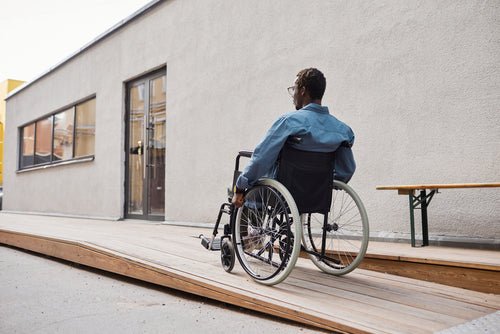
Wheelchair ramps: A simple guide to UK regulations
Wheelchair ramps are a vital part of everyday life for wheelchair users. They make buildings much more accessible and travelling much more convenient.
With wheelchair ramp installations in homes and public spaces, it’s important to understand the regulations surrounding them before use.
Today, Millercare will guide you through the UK rules and regulations for wheelchair ramps for a much safer and more efficient installation.
The importance of wheelchair ramp regulations
Wheelchair regulations ensure inclusivity, allowing individuals with mobility impairments to access buildings and public spaces.
Properly designed and installed wheelchair ramps reduce the risk of accidents and injury, ensuring the safety and longevity of the structure.
The UK regulations for wheelchair ramps
The Equality Act 2010 imposes the responsibility of ‘reasonable adjustment’ on all service providers and public bodies to accommodate those with limited mobility.
Wheelchair ramps must follow technical specifications for the gradient, width, and surface. This also includes various safety features and materials involved in the construction of the ramp.
The Buildings Regulations Part M also play a role, applying to residential dwellings, commercial buildings, and public spaces. This involves the elimination of physical barriers, as well as inclusivity for all disabilities.
Specific design and construction requirements
The Buildings Regulations Part M and The British Standard for Wheelchair Ramps BS8300 (2018) enforce specific requirements for wheelchair ramps, including:
Home installations
- Ramp gradience: The standard recommended gradient is 1:12, meaning for every 12 units of horizontal distance, there is 1 unit of vertical rise.
- Width and space: The ramp should be around 900mm wide, although this may need to be adjusted depending on the home and the user's wheelchair.
- Surface and materials: Non-slip materials must be used to provide a stable surface. These must be able to withstand harsh weather conditions.
- Handrails: The handrails must be between 900mm to 1000mm in height and 30mm to 40mm in diameter. They must be easy to grip and continuous along the ramp without gaps.
- Edge protection: The edge of home ramps should be 50mm to 75mm in height and made from wood, metal, or composite materials for durability and a cohesive appearance. The edge should be made visible with contrasting colours for those with visual impairments.
- Landing area: A flat landing area should be provided at the top of the ramp. For ramps longer than 10 metres, a resting area must be provided in the middle.
Public installations
- Ramp gradience: The ideal gradient for all public ramps is 1:12 for ease of use.
- Width and space: A minimum of 1200mm is required for public buildings to accommodate a range of wheelchairs and needs.
- Surface and materials: The ramp must be made with durable, non-slip materials suitable for frequent use and various weather conditions.
- Handrails: Handrails must be between 900mm and 1000mm above the ramp’s surface and made from ergonomic materials. A diameter of around 30mm to 40mm is necessary. They should extend beyond the ramp for at least 300mm if space allows.
- Edge protection: The ramp edges must range from 50mm to 75mm in height. The materials should be robust but not sharp to avoid injury or damage. It should also be distinguishable in colour or texture for better visibility.
- Landing area: In public areas, landings should be at least as wide as the ramp and have a length of around 1200mm. These should be located at the top and bottom of the ramp, with a rest area at every 10-metre point.
UK wheelchair ramp permissions and compliance
There are certain permissions and compliance requests you must meet for installing a wheelchair ramp:
Permission for residential properties
Contact your local council to understand any local building requirements. To do this, you can also:
- Check local government websites
- Contact local building control offices or planning departments
- Seek advice from professional builders or architects
Smaller ramps may not require planning permission. However, larger ramps or properties in conservation areas, listed buildings, or flats with shared access may require permission.
You will need to consult your local planning authority to understand your rights. This process involves:
- Providing a detailed plan of the proposed ramp
- A site plan showing the ramp with the property boundaries
- A written statement explaining the need for the ramp and how it adheres to local guidelines
Permission for public buildings
Before installing a ramp in a public space, accessibility experts and consultants must be involved. The permit application process involves:
- Submit detailed plans and drawings of the wheelchair ramp
- Provide an accessibility plan which outlines how the ramp meets legal requirements
- Coordinate with local building authorities and accessibility agencies
A building must be inspected to ensure the ramp is safe to install. Public input must also be collected to understand the needs of the public and how the design may affect the building’s appearance.
Historic and listed buildings may require special considerations and approvals to ensure the ramp installation aligns with preservation guidelines.
Invest in a high-quality wheelchair ramp with Millercare
At Millercare, we aim to create a better life for those with mobility issues. This includes creating accessible features that can be installed in the home or offices and buildings for inclusivity.
Our wheelchair ramps are designed to be robust and durable, ideal for installing in the home or public buildings. With durability and safety in mind, each ramp offers ease and comfort for those with limited mobility.
Browse our products today to bring ease back into your everyday routine.
wheelchair users. They make buildings much more accessible and travelling much more convenient.